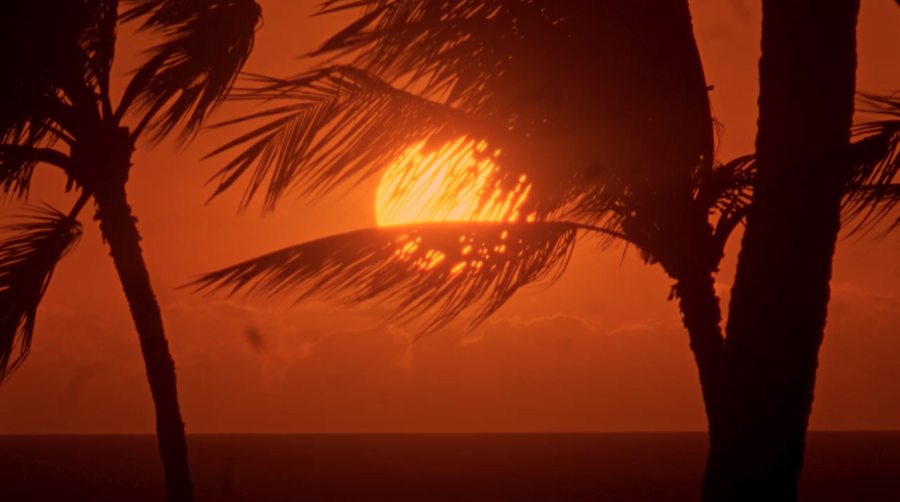Review: ‘Rock Bottom Riser’ rocks
Fern Silva’s feature-length debut is an electrifying documentary on Hawaii. “Rock Bottom Riser” opens this weekend at the Metrograph.
Fern Silva’s “Rock Bottom Riser” is a documentary film about the long and complicated history of Hawaii. The film will debut this weekend at Metrograph. (Courtesy of Cinema Guild)
March 4, 2022
Through his exploration of myth, Fern Silva brings out the realness of places. His feature film debut, “Rock Bottom Riser,” digs deep into the long and complicated history of Hawaii to unearth the historical foldings behind its current problems.
“Rock Bottom Riser” has been described as a visual essay, an ethnographic documentary and a landscape film, among a long list of other formal descriptors. The film embodies them all while also offering up something fresh: cinema as a point of inquiry.
Documenting the attempts to build the Thirty Meter Telescope on Mauna Kea, a massive interstellar observatory on one of the most sacred sites in Hawaiian cosmology, Silva obliquely develops an investigation into Hawaii’s complex colonial history and even longer history of celestial navigation. Through a rollicking collage of sound and images, Silva gathers moments and memories from Hawaiian society so viewers can form their own opinions about the construction of the telescope and what it means for the world.
“Rock Bottom Riser” is a welcome novelty for the film scene: While strictly entrenched in the avant garde, the film remains profoundly accessible thanks to the riveting coordination of engrossing visuals, pounding soundtrack and incisive commentary. Doing away with narrative and leaning on how sound and vision can captivate the mind for 70 minutes, Silva’s film is a spectacle of brilliance.
One of the film’s most striking sequences tracks a lava flow rolling down a highway. Silva, alongside an investigation of societies’ attempts to impose themselves on the islands, captures nature at its most active, reminding viewers the ever-evolving Hawaiian landscape has a spirit of its own that exerts its volatile agency on those who try to inhabit it.
It’s funny how long shots of landscapes have become all the rage in the film scene over the last few decades. To the average moviegoer, a long, still shot of a field might elicit a snooze, but to the informed observer such a shot records life — summing up how a place can define its people, and vice versa.
Stitching together shots of erupting volcanoes, the night sky, theater plays about Hawaiian history, Christian sermons, interviews with activists and underwater footage, “Rock Bottom Riser” contemplates Hawaii from every possible angle. The final result is a mosaic of musings on Hawaiian culture from a director with a deep care for understanding and conveying a place through art.
Silva is more than a filmmaker, working like an archaeologist who offers sights of the world alongside slices of speech like objects in a museum, putting them on display for audiences to contemplate their historical significance. History is a tangled web of compelling facts, according to “Rock Bottom Riser,” a film that pairs oral retellings of journeys across the Pacific with scientific reports on the mechanics of telescopes. Truths emerge from these juxtapositions, as Silva expertly edits together seemingly divergent threads that force the viewer to think through how such disparate concepts can exist in such a small and specific region of the world.
Fern Silva’s singular rendering reflects Hawaii’s own singularity as a remote island in the middle of the Pacific. “Rock Bottom Riser” is a kaleidoscopic tapestry through which to begin exploring Hawaii apropos of politics, history, poetry, religion, geography and just about every possible sociological factor.
For all the questions it poses and extensive research it presents, the film’s most striking feature is the fact that it leaves viewers with much to chew on. “Rock Bottom Riser” does not spoon-feed answers and histories to viewers — rather, it introduces subjects to viewers in the hope that they will continue thinking and researching on their own.
“Rock Bottom Riser” is now on view at the Metrograph at 7 Ludlow St.
Contact Nicolas Pedrero-Setzer at [email protected].

























































































































































